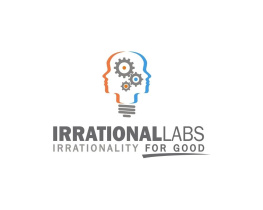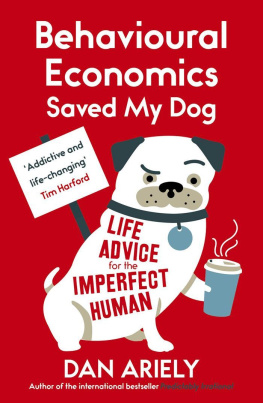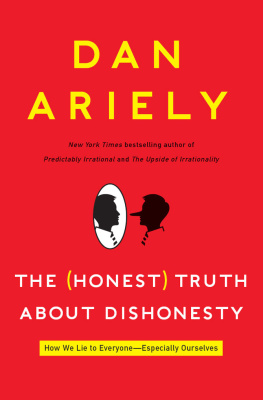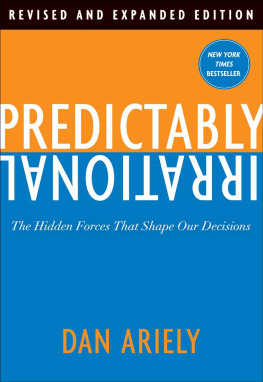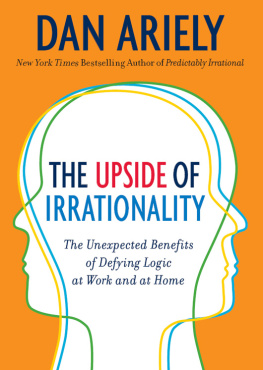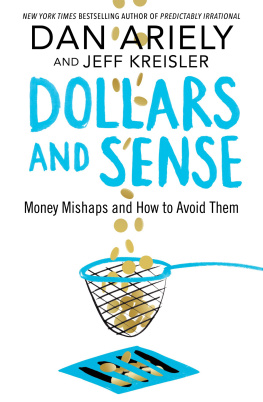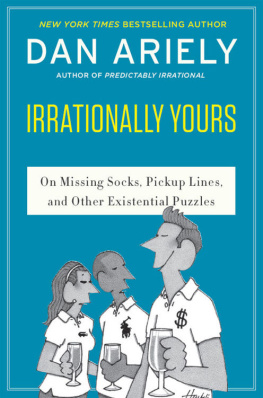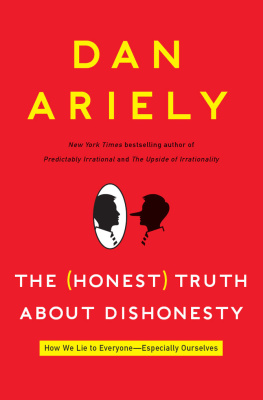Dan Ariely - Hacking Human Nature for Good: A Practical Guide to Changing Human Behavior
Here you can read online Dan Ariely - Hacking Human Nature for Good: A Practical Guide to Changing Human Behavior full text of the book (entire story) in english for free. Download pdf and epub, get meaning, cover and reviews about this ebook. year: 2014, publisher: Irrational Labs, genre: Romance novel. Description of the work, (preface) as well as reviews are available. Best literature library LitArk.com created for fans of good reading and offers a wide selection of genres:
Romance novel
Science fiction
Adventure
Detective
Science
History
Home and family
Prose
Art
Politics
Computer
Non-fiction
Religion
Business
Children
Humor
Choose a favorite category and find really read worthwhile books. Enjoy immersion in the world of imagination, feel the emotions of the characters or learn something new for yourself, make an fascinating discovery.
- Book:Hacking Human Nature for Good: A Practical Guide to Changing Human Behavior
- Author:
- Publisher:Irrational Labs
- Genre:
- Year:2014
- Rating:5 / 5
- Favourites:Add to favourites
- Your mark:
- 100
- 1
- 2
- 3
- 4
- 5
Hacking Human Nature for Good: A Practical Guide to Changing Human Behavior: summary, description and annotation
We offer to read an annotation, description, summary or preface (depends on what the author of the book "Hacking Human Nature for Good: A Practical Guide to Changing Human Behavior" wrote himself). If you haven't found the necessary information about the book — write in the comments, we will try to find it.
-Easy to understand behavioral economics principles, equivalent to a full year of MBA coursework
-Practical exercises you can do by yourself or with your team
Hacking Human Nature for Good: A Practical Guide to Changing Human Behavior — read online for free the complete book (whole text) full work
Below is the text of the book, divided by pages. System saving the place of the last page read, allows you to conveniently read the book "Hacking Human Nature for Good: A Practical Guide to Changing Human Behavior" online for free, without having to search again every time where you left off. Put a bookmark, and you can go to the page where you finished reading at any time.
Font size:
Interval:
Bookmark:

First Edition
We have this new product, but were not sure how to price it. How do we get the most users but still get paid?
We asked our users what they wanted and they clearly said they wanted this feature, but active use hasnt improved. What now?
We have a good core base of users, but they arent referring us to friends. How do we get more of them to love us?
As a product manager, designer, marketer or engineer, you have undoubtedly asked yourself one of the above questions. In order to figure out the answers to these questions, the marketer or engineer may dive into the site analytics or do SQL queries on actions. The product manager may call a few users in for a quick user research session. Sometimes, there is a cross-functional squat team created. This group will sit together in a room and brainstorm potential solutions until the most reasonable and feasible idea is agreed upon by a majority (or at least by the decision maker).
Sound familiar?
As people who create experiences for other people, we work incredibly hard to create and improve these experiences. Sometimes, it feels like trial-and-error, a series of guesses and checks. No matter how many blog posts by successful founders you read, customers you talk with, frameworks you deploy, it never feels like there is an easy answer.Thats because it is hard. In order to create a product that people use and love, we have to really understand our user. We have to understand how this person makes decisions. We must have a sense of what motivates them to try something new. We need to know their world well enough to create things and experiences that would improve it.
To make things even more difficult, these users have busy lives. They are preoccupied with their jobs, their friends, their kids, their social media feeds. Just like you, they feel like there is never enough time to do everything they want to. It would be nice to think that the user cares about us as much as we care about them. Is this really the case? Of course not. But somehow, were hoping to create an experience they use every day, maybe even multiple times a day.
Given these challenges, how should product managers, marketers, designers and engineers attempt to build experiences that people use and love? Wed like to argue in these books that everyone should take the shortcut. Wait, theres a shortcut? Yes! Theres a shortcut.
Its called Social Science. Academics around the world study how people make decisions. They run controlled studies around choice architecture. They pit two incentive plans against each other, head-to-head. They ponder the true price of free. Information on how your customer makes decisions is being published, debated and refined right now.
And yet...the product manager makes a decision about a feature after talking with only five users. The designer uses their intuition to create a landing page or a sign-up flow. When have you ever heard of a designer being asked if there was current research to support his or her decision to redesign the first page of an application? Have you ever heard a marketer explain his brand positioning proposal using theories of loss aversion?
The likely answer to these questions is that you havent experienced thisyet. Wed like to argue that the current approach to solving product and marketing problems within companies is just irresponsible. Its a colossal waste of time. Every team is reinventing the behavior wheel. Every team is rethinking how to influence behavior and starting from scratch.
The purpose of these workbooks is not to preach the benefits of testing. We assume you know them already and are doing some testing. The purpose of these books is to help you come up with ideas for what to test. The purpose of these workbooks is to help you take the shortcut by making the immense amount of existing knowledge about how your customer makes decisions easily accessible.
To do this, we combed through the academic journals that no one but academics enjoys reading and pulled out the most relevant research.
Things to keep in mind:
- This is not an exhaustive review of the research; it is, however, a nice summary of principles that you can test in your product.
- We call this a shortcut. This is not the answer. The academic research provides insights that will help you speed up your development process, but we still encourage you to test new ideas and in particular to test how the different ideas play out in your domain and application.
- These books require thinking (what?!). There is no framework that works every time when it comes to the human mind. Instead, we have to understand the environment and create a specific intervention. This is not drag-and-drop stuff.
After reading these books, you should start viewing yourself as the choice architect at your company. You should take care to shape your users decisions by selecting the environment where the decisions are made, and through the experiences that you create.
We often think people are motivated by grand goals and visions: A great retirement A bikini body An amazing relationship Saving the environment
We all want these things. In fact, its hard to imagine someone who doesnt want their life to be filled with such great achievements.
So then why are we so bad at taking the tiny steps toward these bigger goals? Some people say its because they dont know what to do. If this was truly the case, then the solution is quite simple: We should give them instructions and information. If we tell people how to conserve energy, lose weight or save money, everyone should be able to reach their goals. This is the standard approach to behavior change.
Theres just one problem: It doesnt work.
Financial programs that have tried to help people save money have used the give them information and theyll make the right decision approach for decades. Typical applications in this space show their users how much they could have saved if they made different decisions. They provide users with beautifully-designed pie charts that show them much money they spent on coffee last year and tell them about the benefits of saving money for their future financial well-being.
But does increasing the knowledge available to people about their financial life actually help them make better decisions? The results are a surprising, resounding, and depressing no. In a recent meta-study, researchers looked at over 200 programs that were designed to increase financial literacy to see whether or not they were effective in getting people to save money.
The biggest effect across all of these programs was about 6% improvement. Given all the work put into the program, this is disappointingly low. To top it all off, these interventions were the least effective for people who needed them the mostlow income individuals and their effectiveness was reduced over time.
If educating people about the benefits of money management isnt the right way to improve our financial well-being, then what should we do? Well get to that shortly.What about other domains? Is information equally ineffective in the realm of health/ wellness and environmentalism?
To answer this, we only have to look to New York City. In 2009, the city passed a law requiring all fast food restaurants to prominently display calorie information, so that people could make more informed decisions about their health. Do you think that this lowered the amount of fast food that people ate? In short, no. A few studies found slight decreases in consumption, but a majority found no change in caloric consumption before and after calories were posted on the menu. As you might expect, it is a surprise to no one that McDonalds Big Mac is calorically dense.
Font size:
Interval:
Bookmark:
Similar books «Hacking Human Nature for Good: A Practical Guide to Changing Human Behavior»
Look at similar books to Hacking Human Nature for Good: A Practical Guide to Changing Human Behavior. We have selected literature similar in name and meaning in the hope of providing readers with more options to find new, interesting, not yet read works.
Discussion, reviews of the book Hacking Human Nature for Good: A Practical Guide to Changing Human Behavior and just readers' own opinions. Leave your comments, write what you think about the work, its meaning or the main characters. Specify what exactly you liked and what you didn't like, and why you think so.

